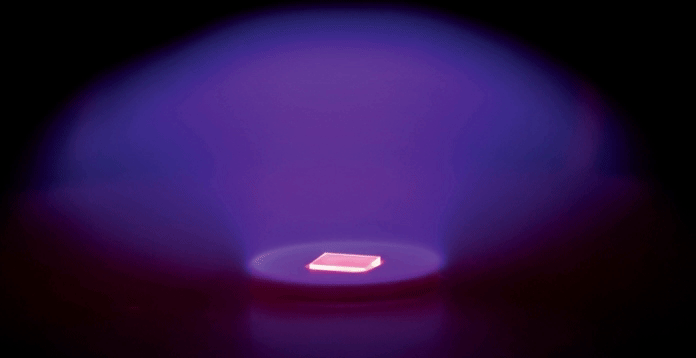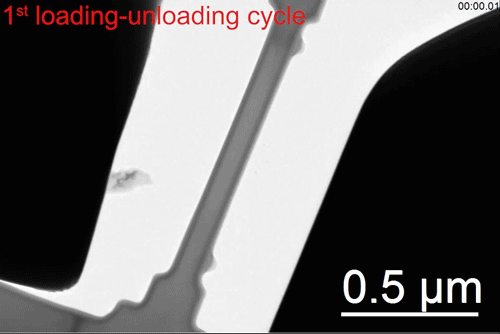Nothing is real, everything is made of vibrations. Take a close look at that pink Subscribe button up and to the right… If you send one vibration into it now you get a million positive vibes every week. Who gives you returns like that? Elon? I don’t think so. You gonna turn down an opportunity bigger than Tesla? Get real (not that that’s possible).
The Search for the Next Semiconductor Super Material Is On
A computer is only as strong as its weakest physical parts. As we run more data through smaller devices at faster rates, circuit board components are being pushed to their limit. Failure means fragging out or going up in a ball of flames, actually. Silicon was the material that facilitated a total paradigm shift in information processing. Unfortunately, it can no longer conduct electrons fast enough to keep up with our insatiable info-appetites. As we round third base on a new computing future, the hardware industry has to keep up its end of the bargain. That’s led to a scorched earth hunt for substances that can power the next phase of growth.
There isn’t a substance on the planet that can withstand and conduct and deliver energy flows like a diamond. The super material’s unreal ability to move electrons has made it the belle of the high-tech ball for five years running. But the punishing demands of quantum leaps in computational power have pushed diamonds to their semiconducting limits too. Since ceilings can’t be a thing, scientists are ‘doping’ diamonds to make them stronger, faster and more efficient. But the yields are incremental.
A team in Hong Kong is taking a radically different approach to the problem: elastic strain engineering. They’re breaking diamonds down to nano-size where they can then be physically stretched. This process opens up the internal bands through which energy can travel, and cranks their conducting power exponentially. Hit the decks, we’re in for an overhaul!
It’s a complex process though and some background helps. So here’s a twinkle-toed trip through the wide world of diamonds.
A Refracted Industry
The high visibility of diamonds as consumer gemstones leaves the gargantuan b-to-b industry mostly unnoticed. Only 20 percent of the mined diamonds on Earth become gemstones. These are glistening specimens with minimal impurities boasting an exquisite specific gravity of 3.52. You know when you pack a snowball and it’s literally perfect in shape, density and hardness? Specific Gravity is the Gemological Institute’s quantifiable equivalent of that. 3.52, chef’s kiss.
Then there's industrial diamonds. These fit into two categories. The first is the other 80% coming from mines. This is the side of the family no one talks to. They are a vulgar army of lumbering cloudy-eyed cousins, all named Bort. The other supply of industrial diamonds is synthetic. These are grown in carefully calibrated laboratory conditions.
To put annual diamond production volumes into perspective, ~142 million carats or 63,000 lbs of gem-grade diamonds are mined each year. A carat of gem-grade diamond runs you about $6,000 but can climb as high as $29,000. That puts the diamond jewelry market at $76Bn/year.
Industrial diamond production - Bort and synthetic - weigh in at ~5 billion carats produced per year or 2.2 million lbs. A carat of Bort goes for $.05 - $.30 cents. The market for industrial diamonds sits in the vicinity of $1.79Bn. Given the unit cost, that’s a cumbersome transaction volume.
So who is buying (and using) all this Bort??
Poor Predictable Bort, Always Picks Rock
Industrial Diamonds are hard AF. We humans discovered this attribute centuries ago and put them to work as an abrasive in grinding, drilling, cutting, and polishing. Diamonds also have chemical, electrical, optical, and thermal characteristics that make them the best material available for corrosion-resistant coatings, special lenses, heat sinks in electrical circuits…the list goes on.
Here’s how industrial diamond consumption breaks down: Stone-Cutting and Highway Building Repair take the number one spot. Next up is the Auto Industry. The manufacture of every automobile in the United States consumes 1.5 carats of industrial diamond. Third is research and high-tech applications.
And now we’re where we need to be.
The Mount Everest of Electronic Materials
The list of technological applications of diamonds is extensive: Semiconductors, Power Management, Solar Energy, Waste Management, Water Purification, Magnetic Field Sensing, High-Power Laser Systems, Quantum Computing and Cancer Detection/Treatment.
There are an array of reasons why diamonds are unparalleled in so many spaces:

In English:
1) Ultra-high thermal conductivity - Diamonds stay cool in super-charged situations.
2) Exceptional electric charge carrier mobility - Electrons move through diamonds with smoothness and efficiency.
3) High breakdown strength - You can pump just a Titanic voltage through a diamond without its structure crumbling.
4) Ultra-wide band gap - If the space through which electrons can flow in a piece of plastic is a sink faucet, then the diamond’s crystal lattice structure is the Hoover Dam of semiconductors. It’s the hot dog in a hallway of thermoelectrics.
It’s Never Enough
The characteristics that have brought the industrial diamond into wide-spread application also come with constantly mounting expectations.
The large band gap and tight crystal structure that make industrial diamonds such incredible semiconductors have their limit. Dying for some way to get a leg up on competition, researchers turn to doping diamonds. The most common practice for increasing the diamond’s electron game is called carbon vapor deposition. Diamonds and the pathways inside of them - called lattice structures - are all made of carbon.
In carbon vapor deposition, labs inject this lattice structure with either boron or nitrogen. Boron has one electron fewer than carbon; Nitrogen has one electron more than carbon. Key is that both manipulate the band gap, the passageway electrons take through the lattice. No one analogy does the trick, but here’s an attempt. It’s time for…
The Diamond Band Gap as an Airport Moving Walkway
Ah the airport moving walkway! What a utopian mode of transportation it is - every type of traveler moving every type of way, all on one glorious metal carpet. Clear the way for the Business Traveler rushing to the front of an arbitrary line. Behold the Juicy Sweatpants Ugg Portable Pillow crew so insistent on not walking they might as well be in reverse. There’s the Family of 12 taking the walkway even though it’s not functioning. And make way for the Disheveled Vodka-Tomato Juice Before Take-off Fanatic, putting more energy into shaking his head than placing one foot in front of the other.
The walkway is our diamond band gap and the travelers are our electrons. There are a bunch of options for how we can change the way people take the walkway. We could slow the conveyor belt down, or we could speed it up. We could widen the belt to allow more travelers to pass through per second. Or we could smear the belt with butter causing the travelers to move side to side. This is essentially what doping diamonds does to their band gap. There’s an endless number of ways to tune the system to let electrons pass through.
There is one restriction. No matter how much you mess with the speed of the walkway, warp the dimensions, or add butter, the planes are all taking off as scheduled. At this point, we’re really pushing the walkway analogy, but that’s where we’re at with doping. There’s only so much the doping can do to affect an electron’s delivery. Until now.
Strain Engineering
The first step in strain engineering is microfabricating diamonds at nanoscale. The ideal shape of each diamond is above. The two thicker ends provide a solid grip while the center gets stretched. Using a pincing mechanism, the tensile pressure is applied and then released in continuous cycles. The stretched area increases in length by up to 9%. When the pressure is released the diamond returns to its former dimensions. It looks like this.
Once that process is under way, researchers jump in to measure the band gap density at different pressures. They’ve found that as tensile strength increases, the band gap decreases. At points beyond 9% tension, direct semiconduction even begins to occur. This a huge deal because it means an electron can make it right through the diamond’s band gap with zero interruption. Long story short, if these findings remain consistent, we’re sitting pretty for the next ten years of optoelectronics.
Beyond a truly mind-blowing feat of micro-engineering, these findings indicate that the next leaps in semiconductor efficiency will come from physically altering the density of substances. The icing on the cake is that this process can be continuous and reversible. Aka, you’ll never have to take your Powerbook into the Apple store to have its diamonds replaced.
While that’s a few years out, The Dawn of a Diamond Age of Electronics, as one industry pioneer puts it, is upon us.
Jump the band gap into our electric diamond future daily.














